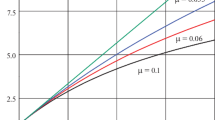Abstract
This study presents the performance optimization of hypervelocity launcher system by using the experimentall data. During the optimization, the RSM (Response Surface Method) is adopted to find the operating parameters that could maximize the projectile speed. To construct a reliable response surface model, 3 full factorial method is used with the selected design variables, such as piston mass and 2 driver fill pressure. Nine test data could successfully construct the reasonable response surface, which used to yield the optimal operational conditions of the system using the genetic algorithm. The optimization results are confirmed by the experimental test with a good accuracy. Thus, the optimization can improve the performance of the facility.
Similar content being viewed by others
References
Arnold. E. Seigel, “Theory of High-Muzzle- Velocity Gun,” University of Maryland, College Park, MD, 1978.
Lukasiewicz, J., “Experimental Methods of Hypersonics,” Marcel Dekker, INC., New York, 1973, pp. 45–50, 207–236.
D. W. Bogdanoff, R. J. Miller, “Optimization Study of the Ames 1.5” Two-Stage Light Gas Gun,” 34th Aerospace Sciences Meeting and Exhibit, January 15–18, 1996/Reno, NV.
Myers, R. H. and Montgomery, D. C.,Response Surface Methodology, John Wiley & Sons Inc., 1995.
Jeon, K. S.,Collaborative Optimization and the Response Surface Modeling for the Multidisciplinary Design Optimization, Master’s thesis, Konkuk University, Seoul, Korea, Dec. 2000.
Giunta, A.,Aircraft Multidisciplinary Design Optimization Using Design of Experiemnts Theory and Response Surface Modeling, Ph.D Thesis, Verginia Tech, 1996.
Micalewiz, Z.,Genetic Algorithm + Data Structures = Evoluation Programs, Springer-Verlag, 1996.
J-H Lee, C-J Huh, K-J Bae, Y-H Byun and J-W Lee, “Performance Optimization of Hyper- velocity Launcher Through Experiment,” Proceeding of the KSAS Fall Annual Meeting, Nov. 2002.
B-C. Choi, K-J. Bae, K-S. Jeon, Y-H. Byun, J-W. Lee, C-J. Huh, J-W Chang and O-H. Rho, “Performance Optimization of the Hypervelocity Launcher System Based on Experimental Results,” AIAA 20020274, 40th Aerospace Sciences Meeting and Exhibit. Jan. 2002.
O-K. Lim and J-S. Lee. “Structural Topology Optimization for the Natural Frequency of a Designated Mode,” KSME International Journal, Vol. 14, No. 3, 306 2000.
Author information
Authors and Affiliations
Corresponding author
Rights and permissions
About this article
Cite this article
Huh, CJ., Lee, JH., Bae, KJ. et al. Performance optimization of hypervelocity launcher system using experimental data. KSME International Journal 18, 1829–1836 (2004). https://doi.org/10.1007/BF02984331
Received:
Revised:
Issue Date:
DOI: https://doi.org/10.1007/BF02984331




